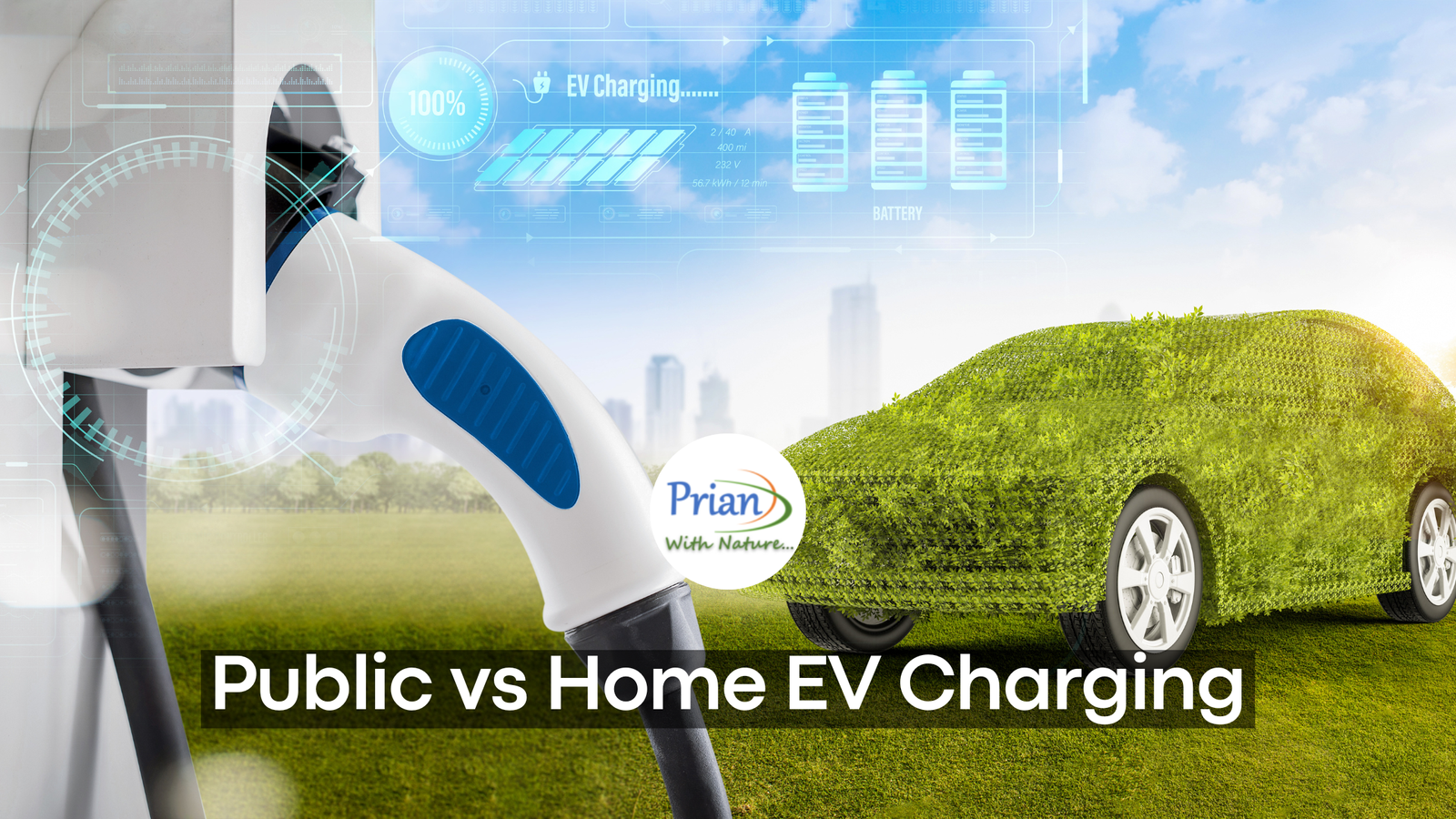Electric vehicles (EVs) have revolutionized the way we think about transportation. Public and Home EV charging are the two places to charge your EV.
Along with the eco-friendly appeal and exciting tech, EV ownership comes with an important question: where should you charge your car?
You’ve got two main options: charging at home or using public EV chargers.
While both have their merits, the choice between them can depend on factors like convenience, cost, and your specific driving habits.
Let’s dive into what makes these two charging methods different, their advantages and disadvantages, and why, for many EV owners, home charging might just be the best option.
Understanding the Basics of EV Charging
Before we compare home vs public charging, it’s important to understand how EV charging works.
But before you dive deeper, we’d recommend that you read our AC vs DC charging guide, as this will not only explain fast vs slow charging in EVs but also clear out the basics for those who need more comprehensive knowledge.
Charging an EV is a bit like charging your smartphone but with more power!
Electric vehicle chargers come in three main types based on the speed at which they charge:
- Level 1: This is the slowest form of charging, usually plugged into a standard 120V home outlet. It’s perfect for emergency or overnight charging but takes a lot of time (we’re talking 8-12 hours for a full charge).
- Level 2: Found both at home (if you’ve got a dedicated charger installed) and in public, Level 2 chargers are different than Level 1 chargers as they use a 240V outlet and can charge most EVs in 4-6 hours. This is ideal for overnight charging at home or topping up while out shopping.
- DC Fast Chargers (Level 3): These are the fastest chargers, typically only available in public spaces. They can charge your car to 80% in about 30 minutes. Perfect for long road trips but not something you’d install at home due to the high cost.
Now that we’re clear on the types of charging, let’s compare the two main charging environments: home vs public charging.
Home Charging: Convenience at Your Fingertip
Charging your EV at home is pretty straightforward. You just plug in your vehicle while you’re sleeping or going about your day, and by the time you’re ready to hit the road, your car is fully charged.
Advantages of Home Charging
- Convenience
Home charging is all about ease and convenience. You never have to search for a charging station or worry about the charger being occupied. It’s like having a personal gas station in your driveway. You set your charging schedule, and everything is under your control. - Cost-Effective
Charging at home is typically cheaper than public charging stations. You’ll only be paying for electricity, and depending on your electricity provider, you might be able to take advantage of off-peak rates. Some areas even offer special EV tariffs, which make home charging even more affordable. - Overnight Charging
For most EV owners, charging at home happens overnight, which fits perfectly with the car’s natural downtime. You don’t need to wait around for your car to finish charging, and by morning, you’re ready to go with a full battery. - Long-Term Savings
Installing a home charger might seem like an upfront expense, but in the long run, it pays off. You save on frequent trips to public charging stations and avoid the sometimes higher fees they charge. - Less Wear on the Battery
Charging at home, especially using a Level 2 charger, is gentler on your EV’s battery compared to fast charging. Fast charging, while convenient, can cause the battery to heat up, which may degrade its lifespan over time. - Smart Charging Options
Many home charging setups come with smart features, allowing you to monitor and control charging through an app. You can set the charger to power up during off-peak hours, reducing your energy costs even further.
Disadvantages of Home EV Charging
- Installation Cost
To install a Level 2 home charger, you’ll need to invest in the charging station and pay for the installation by a qualified electrician. While this is a one-time cost, it’s something to consider if you’re on a tight budget. - Limited Power Supply
If you don’t have a dedicated 240V outlet, you might be stuck with slower charging times using a regular wall outlet (Level 1). This isn’t a big issue if you’re charging overnight, but for anyone with high mileage needs, it might not be fast enough.
Public EV Charging: Power on the Go
Public charging stations are scattered around cities, highways, and shopping centers, offering the convenience of charging while you’re out and about.
Advantages of Public EV Charging
- Accessibility
Public chargers, especially DC Fast Chargers, allow you to quickly top up your battery while you’re running errands or traveling long distances. If you’re on a road trip, they’re a lifesaver, helping you get back on the road in as little as 30 minutes. - No Installation Costs
Public charging stations don’t require you to install any equipment at home. If you live in an apartment or don’t have a garage, public charging can be the easiest solution. - Flexible Locations
Charging stations are increasingly found in more convenient locations like shopping malls, restaurants, and office buildings. Some businesses even offer free charging as an incentive for customers, allowing you to charge your EV while you go about your day.
Disadvantages of Public EV Charging
- Higher Costs
Charging at a public station is generally more expensive than charging at home, especially at DC fast chargers. Some stations charge per minute, which can add up quickly, particularly if your EV’s battery is large. - Availability
Depending on where you live, finding an available public charging station can be tricky. Even in areas with multiple stations, there’s always a chance that they could be occupied or out of service. - Waiting Time
Public chargers may not always be available when you need them. In some busy locations, you might have to wait for another EV to finish charging before it’s your turn. This could disrupt your travel plans and add frustration to your day. - Less Battery-Friendly
Frequent use of DC fast chargers can affect your EV battery’s long-term health. While they’re great for quick top-ups, repeated exposure to fast charging can lead to faster battery degradation.
Home Charging vs Public Charging: Which One’s Right for You?
Choosing between home and public charging comes down to your personal needs and lifestyle.
Let’s break it down:
- If you have a short daily commute and a predictable schedule, home charging is probably the best option for you. You can charge overnight and have a full battery each morning without the hassle of finding public stations.
- For EV owners without a garage or access to home charging, public stations are a convenient alternative. However, you’ll want to plan to avoid the inconvenience of unavailable chargers.
- Road trippers and long-distance commuters might benefit from a combination of both. You can use home charging for your regular needs and rely on public chargers for long journeys.
But here’s the thing: even for long-distance travelers, having a home charger installed gives you the peace of mind that you’ll always have a fully charged car when you start your trip.
Why Home EV Charging Might Be Your Best Bet
Now that we’ve compared both options, it’s time to address the elephant in the room: why home charging often comes out on top.
Simply put, home charging gives you control.
No waiting, no surprise fees, and no worrying about battery degradation from frequent fast charging. Plus, the convenience of plugging in your car when you get home and waking up to a full charge can’t be overstated.
It Is More Than Just A Convenience
Home charging isn’t just about skipping the public station. It’s about long-term savings, maintaining your battery’s health, and having full control over how and when your car charges.
Sure, installing a home EV charging station might require a bit of investment upfront, but the payoff is massive.
Once it’s installed, you’ll have your own private EV charging station ready whenever you need it. And with the ability to charge during off-peak hours, you’ll save on electricity costs too.
So, if you’re debating whether or not to install a home charging station, the answer is simple: it’s a long-term win.
Conclusion: The Power of Convenience
Whether you’re a city driver, a road tripper, or someone in between, having access to reliable charging is a must.
Public charging stations are great for on-the-go top-ups and long journeys, but nothing beats the convenience, cost-effectiveness, and long-term benefits of home charging.
And if you’re looking for the best home charging solution, look no further than Prian Energy’s home EV charging stations.
With efficient performance, affordable pricing, and an easy installation process, it’s the perfect way to keep your EV powered up and ready to roll.


Leave a Reply